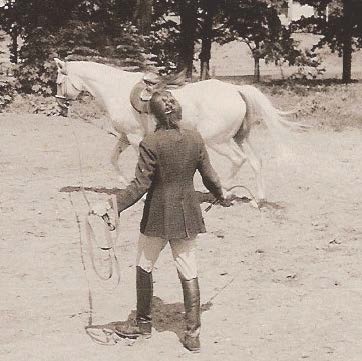 |
 |
Correct lunging and riding is an art which requires skill. Applying
these skills to train a horse is even more complicated. When asked to do a clinic, Kristin Hermann decided that rather than
do another riding clinic if riders could develop good lunging skills and learn about what is required for a good basic riding
position, then their dressage could become that much easier. The hardest part of dressage is getting the horse to be on the
aids, thus lunging in side-reins can help to develop the horse's correct top-line and having the correct riding position enables the rider to put the horse on the aids to keep
it “on the bit.” Too often equestrians think of lunging as a means to get extra energy out of the
horse and not as a training tool. Lunging is a training tool that can help to develop relaxation, rhythm, and the horse's
top-line to be round. These are the first three requirements on the United States Dressage Federation's (USDF) Training Scale
of Training that can be developed under saddle and while lunging. Lunging, however, is not just running a horse in a circle.
Lunging to train the horse requires skill and finesse, as does riding. The ability to coordinate a twenty foot line with a
horse on the end and coordinate walking in a small circle is quite a feat! Kristin believes that being able to lunge a horse
will help all riders develop better aid coordination, which is required for riding. She recommends lunging horses that do
not challenge the lunger to develop the required skills, such as a horse that will not turn in and face the lunger if she
gets in front of its withers. If a rider practices developing good lunging skills on a horse that knows how to lunge and does
not act up, it will help to train his or her lunging skills. Only start using training aids when you can lunge comfortably
without fearing the horse or making the horse nervous. In other words, be comfortable lunging a horse before you attempt to
lunge a horse with the purpose of training.

The lunger stands in line with the saddle and
asks the horse to move away from the whip or legs. Here is a photo of Kristin lunging in the late seventies while horsing
around in Germany. She has the whip behind the horse, pointing toward the hocks, asking the horse to move forward. The lunge
line is attached over the poll, encouraging the horse to stretch down. The lunge line needs to be butterflied into her hand
to be more organized and safe.
Lunging is similar to riding in that
the lunge whip is the legs asking the horse to go forward, and the reins are the lunge line only about twenty five feet long.
The lunge line is held the same as the reins with a ninety degree bend in the elbow. This enables the elbow to be elastic
going forward and back if necessary. If a rider does not know how to lunge, it is recommended they get some lessons and practice
on trained horses.
To read more, please click on the link below to download this article to read it in a new window.
Click here to open the Lunging 101 and Basic Position Clinic article.
|



